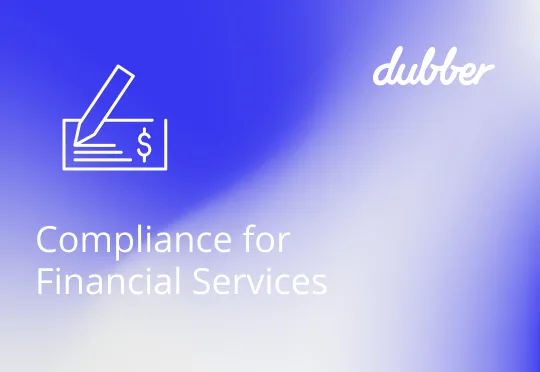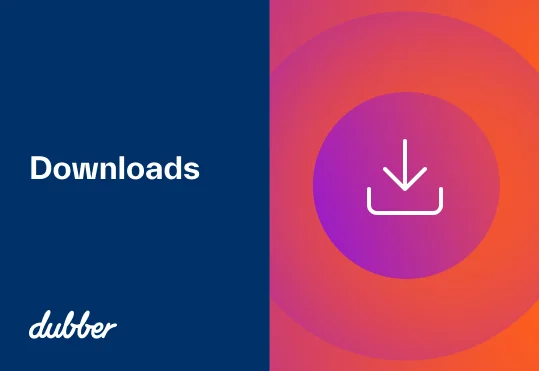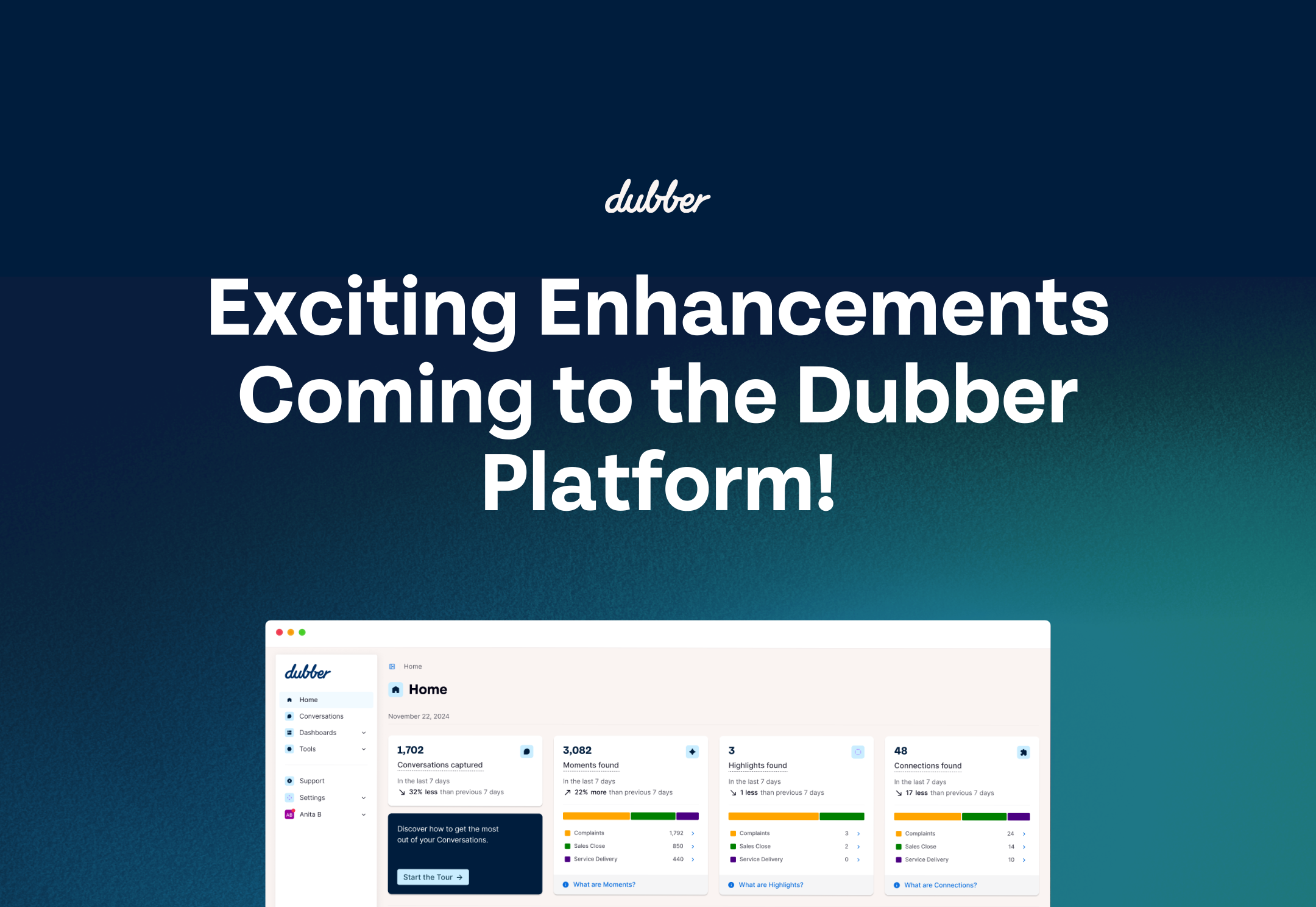
Everyone should be able to access their voice data – no matter the size of their business. Unified Call Recording and voice AI doesn’t need big budgets for up-front spending, or a big office to store bulky on-premise recording equipment. Even small business owners can see great return on investment when they start recording their calls.
1. Gain greater visibility and easily resolve disputes
Phone calls remain the dominant form of business conversation. Email, chat, and messaging are all good for quick transactional communications but, especially with the increase in remote working, the most important conversations happen on voice or video calls. Unfortunately the data from those conversations is lost as soon as the call ends.
If the call was recorded from your service provider network (with no hardware or software to install), it could be replayed from anywhere, you could review a full transcript, and receive alerts and reports on customer satisfaction based on the sentiment of calls.
Imagine you are Chris, who has run his building business for decades and is slowly handing responsibility to his two sons as he edges towards retirement. He still wants to keep track of his team and their jobs as he trains the new company directors and sometimes worries about who has committed what and at what price.
By recording conversations across all company phones, Chris has greater visibility while letting his sons take leadership over the business operations. Easy to digest call transcripts allow him to quickly assess upcoming commitments and sentiment analysis shows how happy customers are. Chris can even search by keyword for specific jobs and set up alerts for negative sentiment to ensure that any unsatisfied customers are followed up with.
While call transcripts provide Chris with peace of mind, the rest of the team also benefit from having proof of their conversations. When it comes to final invoices, they have the reassurance of knowing exactly what was agreed between them and the customer and are protected in the case of any disputes.
2. Train staff in proven sales techniques
The phone is one of a sales rep’s most important tools as they build their relationship with existing customers and nurture leads towards a sale. Sales people hone their pitches and techniques to a fine art and adapt their messaging depending on the product and the contact. In an ideal world, they’d be able to pass this knowledge onto new team members, but this can be difficult unless they listen into every conversation. By recording calls, sales leaders can isolate successful sales pitches and use these as the basis for staff training.
Alex is the owner of a tech startup that is focused on driving growth. Alex has recently employed a number of new sales staff and is keen for them all to get behind the company messaging with effective sales pitches that turn leads into customers.
By recording calls, Alex can repurpose conversational content for coaching new team members. Sentiment analysis of recordings can identify happy customers, and this data can be cross-referenced with the status of leads and deals to find the top performing messaging. This data also makes it easy for Alex to measure the achievements of the team and reward their hard work.
3. Improve customer experience through data-driven insights
Salesforce is the source of truth for sales people, who use it to track their interactions with their customers. Imagine if those interactions were available within Salesforce itself. You could recap a conversation, refer to a transcript, and see who else at the business has spoken to your contact and know exactly how they feel about the brand and at what stage of the purchase journey they are at.
Charlie owns a fashion brand and has a sales team that works with department stores and online retailers to stock the brand. Charlie is interested in how data can inform business decisions but is a complete beginner when it comes to data science. With a free Google Data Studio account, Charlie can use templates to see reporting from sales calls and get a quick insight into how the team is performing.
By integrating recorded calls with Salesforce, Charlie can see a more granular view of sales interactions. Sentiment analysis can give a report of customer satisfaction at a call level, while Charlie can also set up reporting for how wholesale customers are feeling about the brand by week or by month. One staff member might spend more time on the phone than others, and by viewing this data alongside their sales performance Charlie can see that these longer conversations build relationships with customers. By applying this knowledge to the rest of the business, Charlie can improve customer retention.
4. Reduce churn with customisable automated alerts
Call recording is vital for legal firms to store a secure record of their conversations with clients. But these calls could provide valuable insights rather than being locked away with no further action. The data held within these conversations could provide the information required to increase client satisfaction and loyalty.
Ruth runs a family law firm, with her two daughters employed as divorce lawyers. Ruth spends a lot of time trying to win big clients and maintain good relationships with her existing clients. She wants to make sure that the firm is providing excellent service to keep her clients happy and loyal.
With automated alerts, calls are automatically flagged for review. Ruth can set up custom parameters for notifications, either via email or to automate processes in software such as a CRM tool using an API. She might want all calls with negative sentiment to be sent to her inbox so she can check whether there is anything she needs to follow up on, or there might be a particular client she is worried may leave in favour of a competitor and so set an alert for any calls to or from their number.
Call transcripts provide a simple and easy way to review key conversational content and detect unhappy clients and Ruth can even review these when she is at home, or travelling between client meetings. With her secure login and specific permissions, she can access calls from any location or device.
5. Stop taking notes with instant call and meeting transcripts
Dispersed workforces are more common now than ever before, and communication is being put to the test. Sharing information with team members via email and Slack can lose nuance and tone but involving a huge team in client conversations can be unwieldy and lead to interruptions and sidetracking.
Robin is the owner of a content agency with a roster of freelance copywriters, graphic designers, and video creators. Robin spends most of the day meeting clients to get a detailed brief of their needs and chooses the appropriate member of the team to create the required content.
By recording client calls and meetings, Robin doesn’t need to take notes and can really be in the moment with clients and have time to think and ask all the right questions – safe in the knowledge that a full transcript of the conversation will be waiting. Working with a dispersed workforce, Robin relies on being able to share details of jobs with the team of content creators. With secure sharing, conversations can be accessed by the freelancer undertaking a job so they know exactly what is required.
All of this is possible with Dubber. Are you a small business owner thinking about getting call recording? Speak to a member of our team today for advice on the right subscription for you.

Any business in a highly regulated industry will understand the extra compliance measures they need to take to ensure they meet the required standards.
This is particularly true in the financial services industry. With more than 80% of business interactions being voice, businesses place themselves at risk if these crucial conversations are not properly captured. Customer disputes may take longer to resolve leading to customer’s losing trust in their financial institutions, expensive lawsuits, and brand damage.
But how can businesses efficiently and seamlessly prevent many of these issues escalating and damaging reputation, regulatory fines, and worse?
The answer is Unified Call Recording (UCR) and voice data analytics.
UCR allows businesses to meet compliance mandates by implementing Dubber into their telephony and UC systems. Here are five ways that Financial Services can use Dubber to mitigate any compliance risks to their business.
1. Fraud detection – While financial institutions have regulations in place to detect inappropriate or fraudulent behaviour, UCR and voice analytics provides them with a holistic overview of all customer interactions across the business. Breaches of policy can be alerted immediately. Investigations conducted using real-time search. Insightful call transcriptions provide the ability to analyse these interactions for any discrepancies or anomalies in behaviour.
2. Know your customer (KYC) – Call recordings provide a full record of a financial institution’s dealings with the customer, satisfying the major criteria of correctly identifying the individual customer or entity. Dubber features such keyword search allows Team Leaders to audit these calls to ensure that proper KYC procedures were adhered to when dealing with the customer. Dubber’s sentiment analysis also provides businesses with an understanding of how a customer feels about their business helping them to modify the way they service that customer.
3. Increasing transparency with auditors and regulators – Call recording not only benefits clients, but also financial advisers, and the corporate bodies who regulate the industry. Dubber’s API’s enable financial adviser’s to automatically transfer call recordings to their relevant client files, eliminating the need to manually take notes and ensuring all information pertaining to that client is held in the one file. This allows internal compliance teams to conduct audits and investigations more efficiently by allowing them to view all customer interactions in the one file.
4. Acting in the client’s best interest – Any institution providing financial advice must act in the client’s best interest. Unified Call Recording safeguards both the client and the adviser, ensuring any issues of miscommunication or claims of inappropriate advice are eliminated and client disputes can be resolved faster. Dubber’s Legal Hold feature also protects both the business and the customer by ensuring that selected call recordings can never be deleted, further helping businesses with client disputes.
5. Client data management – Local Privacy Laws may specify that businesses only hold on to customer data for a specified period of time. Dubber’s data retention feature allows businesses to comply with their local privacy laws by allowing call recordings to be automatically deleted after a specific period of time. This ensures businesses are only storing relevant information, and not unnecessarily holding on to customer data, minimising risks for both the business and the customer.
Dubber’s Unified Call Recording and Voice Data Intelligence has a myriad of use cases for any heavily regulated business. Schedule a time to meet with a Dubber sales representative to learn more about financial services applications.

Dispersed workforces, remote call centres, and increasing customer and employee connections across mobile devices. These are just a few of the impacts of COVID-19. Hallway conversations, listening in, and on premise systems once gave leaders some insight to the conversations taking place between employees, customers, and suppliers. For many that has become difficult, if not impossible. Costly and limited on-premise call and conversation capture can’t keep up. A move from legacy call recording to the cloud has become a priority.
With a remote workforce, enterprises are asking how to capture crucial conversations. The number of IP connections has grown rapidly with more calls occurring remotely than on premise. However, regulatory demands remain in place: requiring secure, long-term storage of calls. Enterprises are looking for keyword reporting, sentiment analysis, and accurate and accessible transcriptions to quickly view call data, and receive custom alerts.
Accelerating to the cloud
This change is reflected in the broader shift to cloud-based solutions. Where this was once part of a longer-term digital transformation strategy, it has now become accelerated. 93% of IT decision makers are moving their cloud adoption programmes forward. Budgets will be shifted towards cloud solutions that facilitate our new way of working, with 52% seeing an increase due to the pandemic.
Optimised for remote work
We created Dubber to enable any business conversation to be captured and converted to actionable insights, no matter where it takes place. We couldn’t have imagined a scenario like COVID-19, where a dispersed workforce would make cloud call recording so critical.
With automated provisioning and no need for on-premise equipment or management, we make it easy for businesses looking to move to the cloud. We can even migrate historic recordings to cloud storage to ensure minimal risk and disruption as this change takes place. From then on, businesses can be assured that their communications can continue as normal, no matter where their employees are working from.
Business insights from a dispersed workforce
While our cloud call recording means that compliance mandates can still be met regardless of where staff are working from, this is just the beginning. Our voice AI is where businesses see real value. They are identifying opportunities to reduce churn, sharpening investment decisions, and improving the quality of conversations with customers. All this from the data held within their voice calls.
Four voice data imperatives
- Call recording isn’t the answer. It’s an answer, but not the answer. Voice data remains one of the great untapped opportunities in the enterprise. To unlock the data within is where the answers lie.
- AI isn’t just a convenient buzzword. When talking about AI, most call recording vendors are referring to transcription. This is just the first step. The real imperative at the heart of Dubber is using AI to enable advanced analytics, workflow management, sentiment analysis, and more.
- Break free of application, storage and device silos. Legacy call recording platforms imposed high-costs, limited storage, and restricted call capture. This only gave enterprises a partial view of what was happening, and locked data into proprietary dashboards. Our open API, data exporter, and application integrations allow you to use call data across your business.
- Secure your voice data. We capture voice data at the network level, and secure it with market-leading technology. Recording to local storage or application clouds outside of your control is high risk. Your voice data is as important as any other data, and should be protected.
The voice data revolution is just getting started. Getting your voice data strategy right today sets you up for long-term success and will help bridge the distance created by COVID-19.

Dubber Annual Report 30 June 2020

Dubber to acquire CallN

Proposed issue of securities

Dubber goes live on Cisco Global Price List

Dubber raises $10m

Now more than ever, businesses are moving towards agile workforces that aren’t tied to a location or device. Infrastructure and operations leaders are looking to create perimeterless workplaces that enhance operations while maintaining high security standards.
As we have seen over recent weeks, digital business requirements have accelerated the adoption of cloud services in order to support remote workers. Cisco’s video-conferencing Webex service registered a record 324 million attendees in March, with usage more than tripling in the APAC region. With workers switching from office PCs, to laptops in their home office, to smartphones or tablets in their living rooms, businesses need to ensure that they can do their job, no matter the device. This changing work style is described as a perimeterless workplace.
Mobile access to business tools require appropriate security precautions to ensure that access to information is controlled. With users transitioning between devices, networks, and applications, it can be difficult to maintain a seamless experience. By migrating to the cloud, organisations can enable these new ways of working without the need for local networks or VPNs and still maintain security standards. The adoption of cloud services allows users to be productive across a range of devices.
Removing perimeters with the cloud
Dubber cloud call recording and voice AI has been designed with remote work in mind from the very beginning. We connect to service providers directly through their networks: capturing calls directly from the source and securely storing them in the cloud, with no need for any on-premise equipment. With no up-front investment required, companies can access our call recording and voice AI services on an affordable monthly subscription. Businesses of all sizes can connect to our services through their telecommunications provider, with no minimums to prohibit smaller firms or self-employed workers. With global data centres, recorded calls are protected by the latest cloud security protocols while maintaining data sovereignty. Not only can calls be captured across fixed-lines and mobiles, with the appropriate permissions they can be securely accessed from any device or location.
Access and security permissions
In order to ensure information security, access management must be put in place for remote workers. Traditionally, access to data may have been restricted to internal networks within offices or corporate-owned devices. Within a perimeterless workplace, access is granted to specific users through authentication, authorisation, and single sign-on.
Within the Dubber platform, permissions settings and team structures are put in place to restrict access to recorded call content. Depending on the permissions status of the user, they may be able to listen to no call content, only their own calls, or the calls of their team. You can read more about our security practices on our security page.
Application integrations
Users working across devices and locations expect a seamless experience. They want to be able to use the same applications wherever they are working. This is why we made the Dubber portal available to use as a mobile app, desktop app, or through a web browser. Our open API also allows for integration with existing business tools, allowing recorded content to be accessible from applications that users already feel comfortable with. Integrations with CRM systems enable organisations to create detailed customer profiles with recorded calls and their transcripts stored alongside other information.
For more information on how our cloud services can be implemented across a remote workforce, talk to one of our team today.

Unifying your business communications is more important than ever before. With the COVID-19 pandemic disrupting working practices, and telecommunications services providers such as Telstra beginning to disconnect older technologies such as ISDN services in Australia, many businesses may be thinking about migrating to a scalable unified communications solution in order to remain connected.
It is expected that cloud communication solutions will replace services such as ISDN, offering significant savings and flexibility for businesses. Voice services will be easier to manage remotely, and the same communications can be deployed across multiple locations for greater integration and resilience. Connecting through the cloud, rather than physical phone lines, frees employees to work remotely. Cloud solutions also allow for omnichannel communications, which are particularly important for businesses as customers increasingly expect to be able to contact companies by a variety of methods.
What is ISDN and why is it being shut down?
The first telephone networks, built in the 19th century, were made of copper phone lines that sent voice data. This technology makes up the public switched telephone network (PSTN), which has been used ever since. The integrated services digital network (ISDN) uses these copper wires to digitally transmit voice and data.
In Australia, the National Broadband Network (nbn™) is superseding older technology such as ISDN. The nbn™ is a nationwide project funded by the Federal Government. The project aims to provide every home and business with fast and reliable internet with the intention that any new telephone networks will now be IP (internet protocol) based. While this means that traditional devices that do not support IP services will not be compatible, there are many benefits to embracing this new technology. Similar initiatives are taking place around the world.
Will my business need to change phone system, and what are the options?
Businesses with ISDN phone systems will need to make some changes, but these needn’t be drastic. In fact, the shutdown can be seen as an opportunity to upgrade organisational communications and save money at the same time. A transition to next-generation communications has the potential to increase flexibility as well as introduce greater functionality.
Many existing phone systems are compatible with SIP (session initiation protocol) solutions, which also allow organisations to add lines as required without the need for additional infrastructure. SIP channels, sometimes called SIP trunking, are easy to set up: the only requirement is a reliable internet connection with the bandwidth to support voice services, creating a virtual telephone line. A hosted IP phone system is a commitment-free alternative to an on-premise phone system. These solutions use an internet connection to provide the usual functionality of a phone system, without the maintenance charges associated with an on-premise system.
VoIP (voice over internet protocol) systems are hosted in the cloud, and are easy to install and maintain as they don’t require physical hardware. These systems use the internet to carry voice data, without on-premise equipment. VoIP doesn’t even require physical phones: softphones can transform a computer into a phone using software.
Future proof your business
While moving your communications to an entirely new solution may sound daunting, the benefits well outweigh any short term (and mild) inconvenience. Modern voice technology like SIP and VoIP can offer huge savings, as well as greater flexibility, scalability, portability, and security. Soft clients on devices enable workers to take all the capabilities of the office with them, wherever they go. Where traditional phone lines required installation in new locations, with IP-based services telephone lines can be easily added and removed, and can be of a higher quality. This future-proofs businesses for any growth, as handsets and portable devices can be connected instantly.
VoIP systems enable mobility through single number reach, allowing users to be reached on one number across multiple devices. VoIP can also incorporate a range of communication methods, such as video conferencing, email, and instant messaging into one solution. This consolidation of communication is referred to as unified communications (UC). Unified communications can bring cost savings and facilitate increased productivity, with users able to work from any location with an internet connection.
VoIP also provides greater potential for business continuity, as it’s not tied to any on-premise hardware. Calls can be diverted easily between locations in case sites are unreachable. UC that is completely hosted in the cloud is referred to as unified communications as a service (UCaaS). A whole range of communication and collaboration applications and services can be deployed through the cloud, and consolidating these services can often simplify billing into a fixed package; making costs more predictable.
To find out more about the kinds of services we offer that can be integrated into a UCaaS solution, get in touch with a member of our team today.

